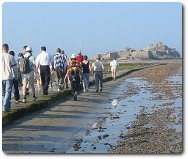The Wife of Bath's Prologue and Tale Contents
Pilgrims and pilgrimage
Who went on pilgrimage?
 People from all levels of the society in which Chaucer lived went on pilgrimage. Many people would have seen pilgrimage towards a particular holy place as mirroring the journey of Christian believers through life towards God and heaven. Some visited churches near to their homes; others travelled long distances within England or even as far as Santiago de Compostela in Northern Spain, Rome or Jerusalem:
People from all levels of the society in which Chaucer lived went on pilgrimage. Many people would have seen pilgrimage towards a particular holy place as mirroring the journey of Christian believers through life towards God and heaven. Some visited churches near to their homes; others travelled long distances within England or even as far as Santiago de Compostela in Northern Spain, Rome or Jerusalem:
- Some went on pilgrimage as a specific penance
- Most went voluntarily, seeking forgiveness, spiritual encouragement or practical benefits such as healing for themselves or others
- Women often went on behalf of their family members or to ask for the ability to conceive a child
- Pilgrimage also offered a chance to escape everyday life and work and see something of the world
- Pilgrims were sometimes criticised for irresponsibility and un-spiritual behaviour.
The Canterbury Tales includes a variety of characters who vary according to rank, education, holiness and their various strengths and weaknesses. To some extent they represent the society, the beliefs and the various ideas of Chaucer's time. Pilgrims going to a shrine were supposed to behave as people on a spiritual journey but pilgrimages could also be treated as holidays and social experiences. The Tabard Inn mentioned in The Tales was a popular starting point for pilgrimage to the tomb of Saint Thomas a Becket at Canterbury.
Pilgrim destinations
Pilgrims travelled to places considered particularly holy. This might be because of:
- Association with Jesus Christ and his Apostles (such as Jerusalem, Rome or Santiago de Compostela in Spain)
- Connection with a person regarded as a saint
- The resting places of saints and their relics were believed to be places where heaven and earth intersected, where individuals might come close to God and have their prayers answered
- Saints were also believed to grant healing from a distance. This was true of St Thomas Becket and the pilgrims in Chaucer's The Canterbury Tales are said to be travelling to his shrine in Canterbury to give thanks for his help when they were sick.
More on relics: Relics are the remains of a saint, such as a bone, or articles which have been in contact with a saint and in which some of the saint's power is believed to reside. These could be articles of clothing, such as the breeches worn by St Thomas Becket which were kept at Canterbury, or dust or chippings from the saint's tomb. It was obviously very difficult to verify the authenticity of such objects so the scope for fraud was very great.
Recently Viewed
Scan and go
Scan on your mobile for direct link.